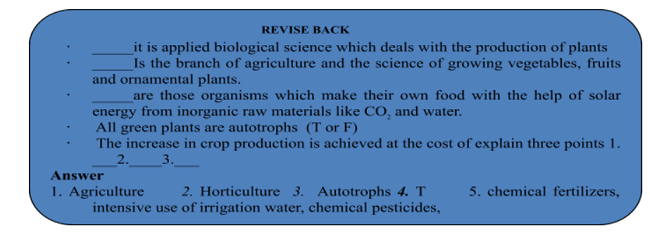
Sustainable agriculture
Improvement of food resources of Class 9
Plenty of energy of human was used in hunting animals and collecting edible plants. About 10,000 BC the man found that by sowing seeds which he had gathered from nearby places, he could produce the whole of plant and produce more food for his daily requirements. This led to start of agriculture in his life. Agriculture means cultivation of crops on a piece of land. Thus man started domestication of plants which were useful to him. He turned from food gatherer to food producer. He observed that vegetative parts of some plants like rhizomes, tubers, corms, bulbs etc. can be utilised for the formation of new plants. This regular food supply can be assured.
Transportation of plants : After the domestication of plants in different parts of the world and knowing the economic value of food plants, these were transported to diverse areas by conquerers, merchants, princes, mariners and explorers. They all took with them seeds of their native plants and return brought home for cultivation whatever they found fit.
Sustainable agriculture
The increase in crop production is achieved at the cost of chemical fertilizers, intensive use of irrigation water, chemical pesticides, etc. This resulted in some problems such as depletion of soil fertility, increase in soil salinization, nutrient imbalance, etc. Therefore, it is the prime concern of the present day agricultural scientists to develop environmentally sustainable techniques to produce enough food to satisfy the hunger of more than a billion people.
Thus, sustainable agriculture may be defined as the practice of farming and production of maximum agricultural yield through management of natural resources without disturbing the environment. It can be achieved by following some steps:
- Crop selection
- Crop rotation
- Mixed cropping
- Mixed farming

Further Reading









